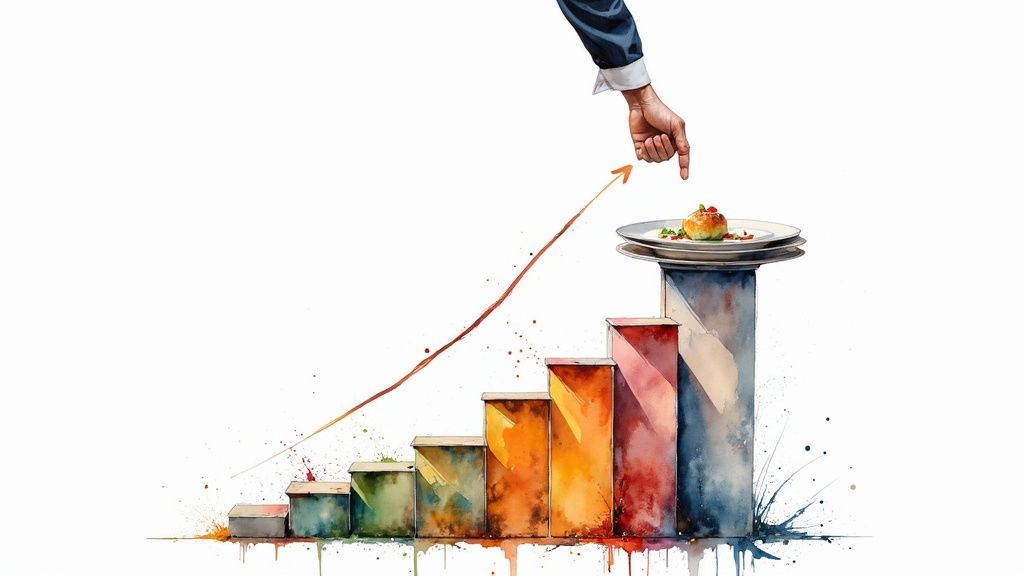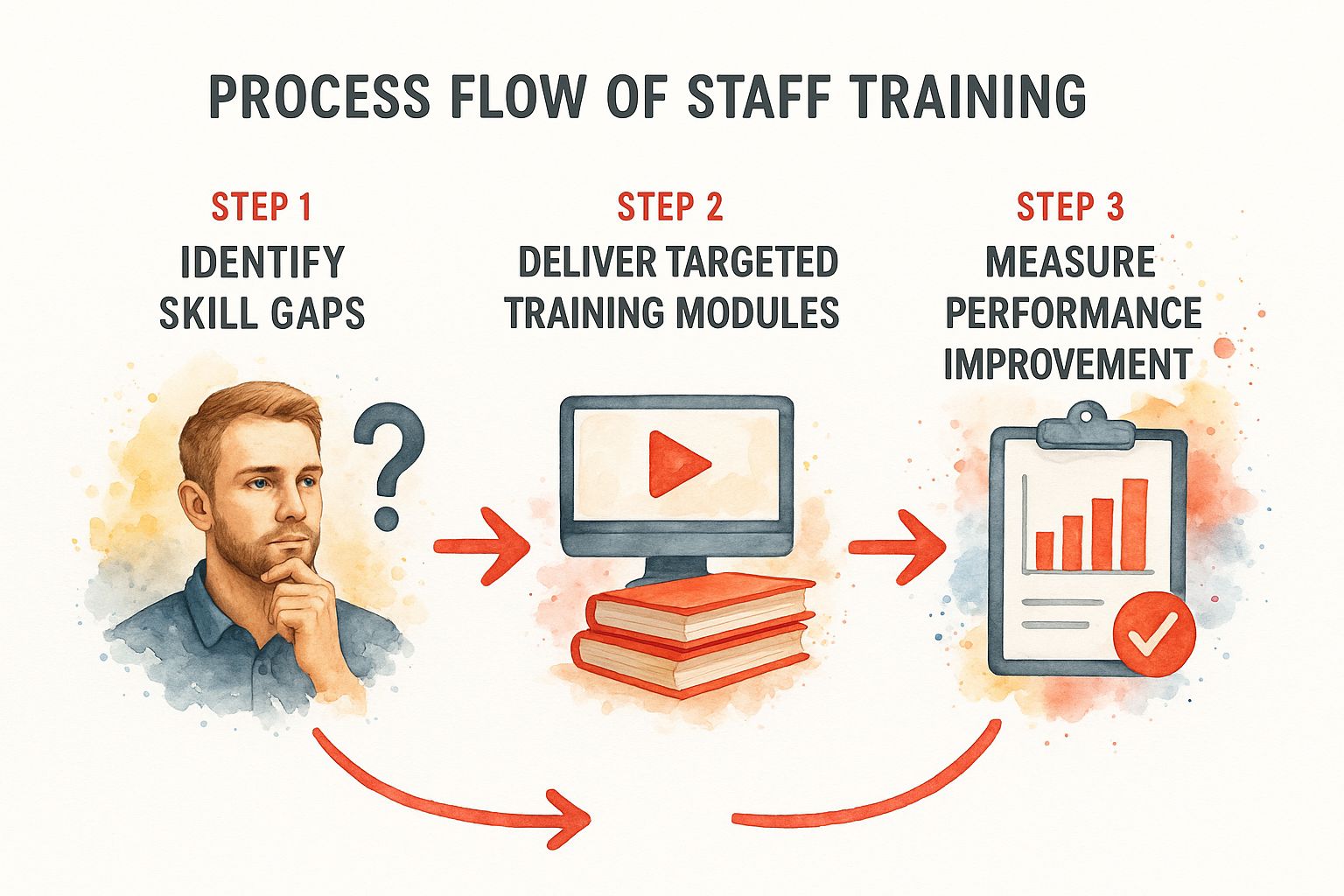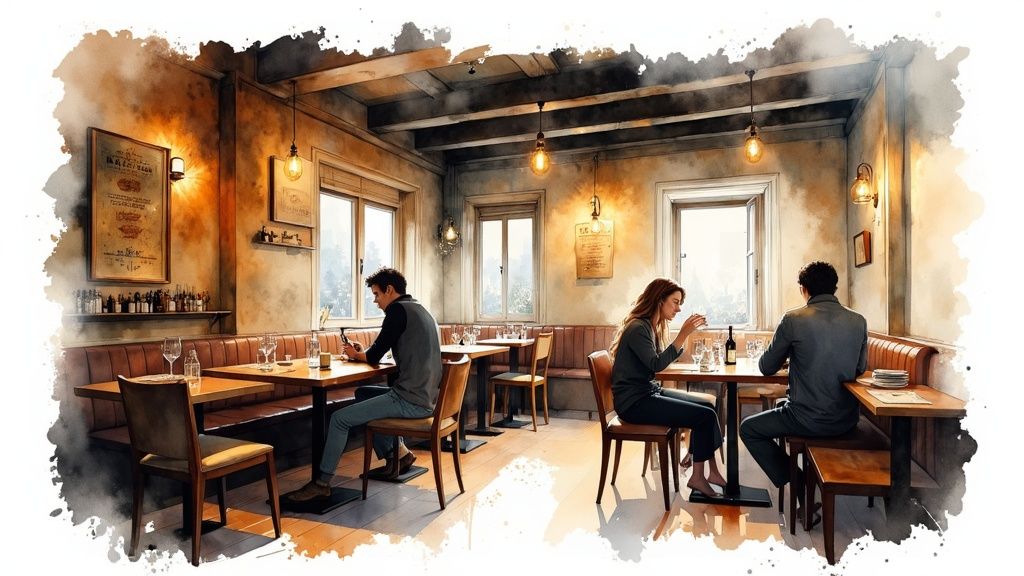Increasing restaurant revenue with proven strategies for your menu, operations, and technology

Every dollar counts when you're wrestling with thin margins and rising costs. The key to growing revenue isn't a massive overhaul; it's about making small, smart changes that add up. This guide gives you actionable strategies you can use right away to make a real difference to your bottom line.

As an independent owner, you're not just running a kitchen—you're the manager, marketer, and accountant. The good news? Significant revenue growth doesn't require a celebrity chef. It starts with what you already have: your menu, your team, and your regulars.
Think of this as a tune-up for your business. We're focusing on practical methods that give you the breathing room to not just survive, but thrive.
The industry is growing, but so are the pressures. U.S. traditional restaurants are projected to hit $1.1 trillion in sales in 2025. While demand is strong, rising menu prices are also part of the story. Nearly half of U.S. restaurants (47%) raised prices last year to keep up with costs.
With average profit margins for a full-service restaurant around 9.8%, efficiency is a necessity. Every operator knows that keeping food costs between 28% and 35% of revenue is critical for staying in the black.
Boosting revenue is a two-sided coin: bringing more money in and controlling costs without sacrificing quality. This means optimizing every part of your operation, including things you might not think about, like driving revenue through smart business energy management.
Before planning long-term projects, focus on changes that can deliver results this week. These quick wins build momentum and give your bottom line an immediate lift.
These small adjustments take minimal effort but can shift customer spending habits in your favor.
Your menu is your most powerful sales tool. Too many owners treat it as an afterthought, but it’s where guests make their most important financial decision. It’s time to stop guessing and start engineering your menu for maximum profitability. The process starts with the data inside your Point of Sale (POS) system.
Every item on your menu falls into one of four categories. Understanding these is key to making data-driven decisions that will increase revenue.
Once you know which items to push, use subtle design tricks to guide guests' choices. Diners' eyes are naturally drawn to the upper-right corner of a single-page menu. This is your prime real estate. Place a "Star" here, maybe frame it in a box to draw attention.
Use descriptive language. "Chicken breast with lemon sauce" is forgettable. "Pan-Seared Chicken Piccata with a zesty lemon-caper butter sauce" sounds irresistible and justifies a higher price.
A simple design tweak, like removing dollar signs ($), has been shown to encourage customers to spend more. Writing prices as "18" instead of "$18.00" makes the cost feel less transactional.

This same logic applies to your menu. Identify high-profit "Puzzles," train staff on flavor profiles, and track sales data in your POS to see how much sales improve.
The key is to price based on perceived value, not just target food cost percentage. If a dish uses premium ingredients and requires skill to prepare, customers will pay more. Don't be afraid to make small price adjustments on your most popular items. A fifty-cent increase on a best-selling burger adds up to a serious revenue boost.
Create a sense of urgency with limited-time offers. Exploring the psychology behind limited-time menu items can give you an edge. Treating your menu like a strategic document can dramatically increase your average check size.
Efficiency is the secret sauce to profitability. When your teams are in sync, you serve more guests, turn tables quicker, and boost revenue without rushing customers. It’s about making every minute of a busy shift count. The goal is to maximize what you can do during peak hours. Little hiccups, like a messy ticket rail, create a domino effect that costs you covers.
The art is in cutting out dead time—long waits to order, the search for a server to pay the bill, or the lag between parties.
The guest's perception is everything. A fast, efficient meal where they never feel ignored is a fantastic experience. A meal where they feel hurried is a reason they won't return.
Overstaffing on a slow Tuesday can bleed your margins just as badly as being short-handed on a packed Friday. Guessing your labor needs is a surefire way to waste money or burn out your team. This is where your POS data becomes your best friend.
Modern POS systems give you detailed sales forecasts based on your history. Use that intel to build schedules that make sense. Instead of scheduling five servers for every dinner shift, dig into your covers-per-hour data. You might discover you need a sixth person from 6:30 PM to 8:30 PM. This data-driven approach means you have the right people when you need them.

Thinking of your POS as just a cash register is a missed opportunity. A modern system is the command center for your entire operation, capable of driving sales and unlocking new revenue streams. It’s about choosing tools that pay for themselves by generating new and repeat business.
Program on-screen prompts that remind servers to suggest high-margin add-ons. When a steak is ordered, a pop-up can suggest, "Offer a side of sautéed mushrooms." This automated nudge can bump up your average check size, adding up to thousands in extra revenue over a year.
Revenue streams beyond your four walls are essential. Integrating online ordering directly into your POS is non-negotiable. This streamlines the process, sending online orders straight to your kitchen display system (KDS). That direct integration eliminates the chaos of juggling multiple tablets and reduces errors. Look for a solution like Peppr Grow with commission-free ordering plus marketing and loyalty. This move lets you keep the 20-30% in commission fees that third-party apps take.
The global restaurant industry is projected to grow from $4.03 trillion in 2025 to $6.81 trillion by 2032. This growth is fueled by consumer demand for convenience, proving how critical it is to adopt technology. You can find a deeper dive into these global restaurant industry trends on Restroworks.com.
Every time a guest makes a reservation or places an order, you’re capturing valuable information. Building this database through your POS is the first step toward creating marketing campaigns that bring people back. You can run targeted email or SMS campaigns to announce new menu items or promote a slow Tuesday night special. To get a better sense of how different tools fit together, check out these restaurant technology solutions that boost profit.
A good loyalty program encourages customers to visit more often and spend more. Modern POS systems have built-in loyalty features that track points automatically, letting you ditch old-school punch cards.
Here’s a simple program you can launch tomorrow:
This tiered system provides an immediate reward while encouraging guests to work toward a larger discount. By integrating this into your POS, enrollment is effortless and rewards are applied with a simple tap.
Your restaurant's revenue potential isn't confined to your dining room. Relying solely on dine-in service is like fighting with one hand tied behind your back. Smart growth comes from diversifying your income with new ventures that complement your core business.
Catering turns your existing kitchen and staff into a profit center. The demand from local businesses for office lunches and corporate events is a massive, untapped market. Start small by developing a specific catering menu with items that travel well. Think about creating bundled packages—like a "Lunch & Learn" for 15 people—to simplify ordering. Focus on building relationships with local office managers. A single corporate lunch can lead to repeat weekly orders. For a deeper dive, our guide on how to maximize catering sales this year offers a clear roadmap.
Let your regulars take a piece of the experience home. Selling branded retail products is an excellent way to generate passive income.
Consider these low-effort ideas:
Data shows that 87% of consumers would purchase offerings from restaurants like cookbooks or cocktail kits. This highlights a huge appetite for products that extend the dining experience.
You don't need a huge investment. Start with one or two items and a small display near your host stand.
Instead of accepting the lull on quiet Tuesday or Wednesday nights, turn them into ticketed events that generate guaranteed revenue.
Offer something unique that guests can't get during a regular service:
These events bring people in on slow nights and attract a new crowd. By selling tickets in advance, you lock in revenue and can staff and prep with perfect accuracy, eliminating waste.
The secret to growing revenue isn't doing everything at once. It’s about putting your energy where it counts. Start by picking one or two things from this guide that feel achievable right now.
A small, focused effort can have a big impact. Your initial push could be as simple as one of these:
Once you see some wins, you can start layering in the next initiative.
The industry is seeing a massive rebound, with U.S. sales projected to hit $1.6 trillion by the end of 2025. But with average margins still hovering at 3-5%, every operational tweak is critical. You can dig deeper into these restaurant industry financial trends on SculptureHospitality.com.
Here are some answers to questions we hear most from independent restaurant owners.
Slow nights are margin killers. Get proactive and create a specific reason for people to come in. Focus on value-driven offers that build loyalty, not just cheapen your brand. Start with a “Weekly Regulars Night.” Use your POS data to find guests who usually visit on weekends. Send them a targeted email offering a complimentary appetizer if they come in on a Tuesday. It’s a smart way to reward your best customers while filling seats. Another great strategy is a prix-fixe menu available only on slower nights. A three-course meal for a set price feels like a special event and can boost your average check size.
Effective upselling should feel like great hospitality, not a sales pitch. The best training is hands-on and focused on enhancing the guest's meal. Focus your team on one specific category per week. During your pre-shift meeting, have your team taste the items you want them to suggest. When a server can say, "The crispy calamari is fantastic tonight," it comes across as an authentic recommendation.
Here’s a simple technique: train your team to make two specific suggestions. Instead of "Want a glass of wine?" teach them to ask, "Would you prefer the Cabernet or the Pinot Noir with your steak?" This small shift in language makes the sale feel natural.
Don't forget to use your POS system to create friendly competition. Post a leaderboard in the back showing who has sold the most of the featured item. A small prize, like a $25 gift card, is often all it takes to get the team motivated.
With costs rising, you probably need to. But you must do it strategically. A blanket 10% price hike across your menu is the fastest way to alienate regulars. Instead, take a surgical approach. Use your menu engineering analysis to identify your "Plowhorses"—popular but low-profitability items. A small price bump of $0.50 to $1.00 on these best-sellers will have a massive impact on your bottom line but is subtle enough that most guests won't notice. On the flip side, avoid raising prices on your high-profit but less popular "Puzzles." Focus your team's energy on selling more of them at their current price.
Ready to put these strategies into action with a POS designed for independent restaurants?
Peppr gives you the tools you need, from menu management to commission-free online ordering, to build a more profitable business. See how Peppr can work for you.
Every dollar counts when you're wrestling with thin margins and rising costs. The key to growing revenue isn't a massive overhaul; it's about making small, smart changes that add up. This guide gives you actionable strategies you can use right away to make a real difference to your bottom line.

As an independent owner, you're not just running a kitchen—you're the manager, marketer, and accountant. The good news? Significant revenue growth doesn't require a celebrity chef. It starts with what you already have: your menu, your team, and your regulars.
Think of this as a tune-up for your business. We're focusing on practical methods that give you the breathing room to not just survive, but thrive.
The industry is growing, but so are the pressures. U.S. traditional restaurants are projected to hit $1.1 trillion in sales in 2025. While demand is strong, rising menu prices are also part of the story. Nearly half of U.S. restaurants (47%) raised prices last year to keep up with costs.
With average profit margins for a full-service restaurant around 9.8%, efficiency is a necessity. Every operator knows that keeping food costs between 28% and 35% of revenue is critical for staying in the black.
Boosting revenue is a two-sided coin: bringing more money in and controlling costs without sacrificing quality. This means optimizing every part of your operation, including things you might not think about, like driving revenue through smart business energy management.
Before planning long-term projects, focus on changes that can deliver results this week. These quick wins build momentum and give your bottom line an immediate lift.
These small adjustments take minimal effort but can shift customer spending habits in your favor.
Your menu is your most powerful sales tool. Too many owners treat it as an afterthought, but it’s where guests make their most important financial decision. It’s time to stop guessing and start engineering your menu for maximum profitability. The process starts with the data inside your Point of Sale (POS) system.
Every item on your menu falls into one of four categories. Understanding these is key to making data-driven decisions that will increase revenue.
Once you know which items to push, use subtle design tricks to guide guests' choices. Diners' eyes are naturally drawn to the upper-right corner of a single-page menu. This is your prime real estate. Place a "Star" here, maybe frame it in a box to draw attention.
Use descriptive language. "Chicken breast with lemon sauce" is forgettable. "Pan-Seared Chicken Piccata with a zesty lemon-caper butter sauce" sounds irresistible and justifies a higher price.
A simple design tweak, like removing dollar signs ($), has been shown to encourage customers to spend more. Writing prices as "18" instead of "$18.00" makes the cost feel less transactional.

This same logic applies to your menu. Identify high-profit "Puzzles," train staff on flavor profiles, and track sales data in your POS to see how much sales improve.
The key is to price based on perceived value, not just target food cost percentage. If a dish uses premium ingredients and requires skill to prepare, customers will pay more. Don't be afraid to make small price adjustments on your most popular items. A fifty-cent increase on a best-selling burger adds up to a serious revenue boost.
Create a sense of urgency with limited-time offers. Exploring the psychology behind limited-time menu items can give you an edge. Treating your menu like a strategic document can dramatically increase your average check size.
Efficiency is the secret sauce to profitability. When your teams are in sync, you serve more guests, turn tables quicker, and boost revenue without rushing customers. It’s about making every minute of a busy shift count. The goal is to maximize what you can do during peak hours. Little hiccups, like a messy ticket rail, create a domino effect that costs you covers.
The art is in cutting out dead time—long waits to order, the search for a server to pay the bill, or the lag between parties.
The guest's perception is everything. A fast, efficient meal where they never feel ignored is a fantastic experience. A meal where they feel hurried is a reason they won't return.
Overstaffing on a slow Tuesday can bleed your margins just as badly as being short-handed on a packed Friday. Guessing your labor needs is a surefire way to waste money or burn out your team. This is where your POS data becomes your best friend.
Modern POS systems give you detailed sales forecasts based on your history. Use that intel to build schedules that make sense. Instead of scheduling five servers for every dinner shift, dig into your covers-per-hour data. You might discover you need a sixth person from 6:30 PM to 8:30 PM. This data-driven approach means you have the right people when you need them.

Thinking of your POS as just a cash register is a missed opportunity. A modern system is the command center for your entire operation, capable of driving sales and unlocking new revenue streams. It’s about choosing tools that pay for themselves by generating new and repeat business.
Program on-screen prompts that remind servers to suggest high-margin add-ons. When a steak is ordered, a pop-up can suggest, "Offer a side of sautéed mushrooms." This automated nudge can bump up your average check size, adding up to thousands in extra revenue over a year.
Revenue streams beyond your four walls are essential. Integrating online ordering directly into your POS is non-negotiable. This streamlines the process, sending online orders straight to your kitchen display system (KDS). That direct integration eliminates the chaos of juggling multiple tablets and reduces errors. Look for a solution like Peppr Grow with commission-free ordering plus marketing and loyalty. This move lets you keep the 20-30% in commission fees that third-party apps take.
The global restaurant industry is projected to grow from $4.03 trillion in 2025 to $6.81 trillion by 2032. This growth is fueled by consumer demand for convenience, proving how critical it is to adopt technology. You can find a deeper dive into these global restaurant industry trends on Restroworks.com.
Every time a guest makes a reservation or places an order, you’re capturing valuable information. Building this database through your POS is the first step toward creating marketing campaigns that bring people back. You can run targeted email or SMS campaigns to announce new menu items or promote a slow Tuesday night special. To get a better sense of how different tools fit together, check out these restaurant technology solutions that boost profit.
A good loyalty program encourages customers to visit more often and spend more. Modern POS systems have built-in loyalty features that track points automatically, letting you ditch old-school punch cards.
Here’s a simple program you can launch tomorrow:
This tiered system provides an immediate reward while encouraging guests to work toward a larger discount. By integrating this into your POS, enrollment is effortless and rewards are applied with a simple tap.
Your restaurant's revenue potential isn't confined to your dining room. Relying solely on dine-in service is like fighting with one hand tied behind your back. Smart growth comes from diversifying your income with new ventures that complement your core business.
Catering turns your existing kitchen and staff into a profit center. The demand from local businesses for office lunches and corporate events is a massive, untapped market. Start small by developing a specific catering menu with items that travel well. Think about creating bundled packages—like a "Lunch & Learn" for 15 people—to simplify ordering. Focus on building relationships with local office managers. A single corporate lunch can lead to repeat weekly orders. For a deeper dive, our guide on how to maximize catering sales this year offers a clear roadmap.
Let your regulars take a piece of the experience home. Selling branded retail products is an excellent way to generate passive income.
Consider these low-effort ideas:
Data shows that 87% of consumers would purchase offerings from restaurants like cookbooks or cocktail kits. This highlights a huge appetite for products that extend the dining experience.
You don't need a huge investment. Start with one or two items and a small display near your host stand.
Instead of accepting the lull on quiet Tuesday or Wednesday nights, turn them into ticketed events that generate guaranteed revenue.
Offer something unique that guests can't get during a regular service:
These events bring people in on slow nights and attract a new crowd. By selling tickets in advance, you lock in revenue and can staff and prep with perfect accuracy, eliminating waste.
The secret to growing revenue isn't doing everything at once. It’s about putting your energy where it counts. Start by picking one or two things from this guide that feel achievable right now.
A small, focused effort can have a big impact. Your initial push could be as simple as one of these:
Once you see some wins, you can start layering in the next initiative.
The industry is seeing a massive rebound, with U.S. sales projected to hit $1.6 trillion by the end of 2025. But with average margins still hovering at 3-5%, every operational tweak is critical. You can dig deeper into these restaurant industry financial trends on SculptureHospitality.com.
Here are some answers to questions we hear most from independent restaurant owners.
Slow nights are margin killers. Get proactive and create a specific reason for people to come in. Focus on value-driven offers that build loyalty, not just cheapen your brand. Start with a “Weekly Regulars Night.” Use your POS data to find guests who usually visit on weekends. Send them a targeted email offering a complimentary appetizer if they come in on a Tuesday. It’s a smart way to reward your best customers while filling seats. Another great strategy is a prix-fixe menu available only on slower nights. A three-course meal for a set price feels like a special event and can boost your average check size.
Effective upselling should feel like great hospitality, not a sales pitch. The best training is hands-on and focused on enhancing the guest's meal. Focus your team on one specific category per week. During your pre-shift meeting, have your team taste the items you want them to suggest. When a server can say, "The crispy calamari is fantastic tonight," it comes across as an authentic recommendation.
Here’s a simple technique: train your team to make two specific suggestions. Instead of "Want a glass of wine?" teach them to ask, "Would you prefer the Cabernet or the Pinot Noir with your steak?" This small shift in language makes the sale feel natural.
Don't forget to use your POS system to create friendly competition. Post a leaderboard in the back showing who has sold the most of the featured item. A small prize, like a $25 gift card, is often all it takes to get the team motivated.
With costs rising, you probably need to. But you must do it strategically. A blanket 10% price hike across your menu is the fastest way to alienate regulars. Instead, take a surgical approach. Use your menu engineering analysis to identify your "Plowhorses"—popular but low-profitability items. A small price bump of $0.50 to $1.00 on these best-sellers will have a massive impact on your bottom line but is subtle enough that most guests won't notice. On the flip side, avoid raising prices on your high-profit but less popular "Puzzles." Focus your team's energy on selling more of them at their current price.
Ready to put these strategies into action with a POS designed for independent restaurants?
Peppr gives you the tools you need, from menu management to commission-free online ordering, to build a more profitable business. See how Peppr can work for you.
